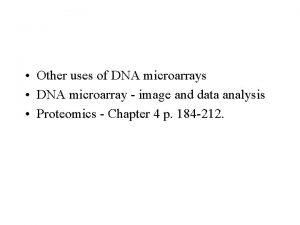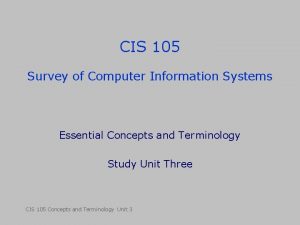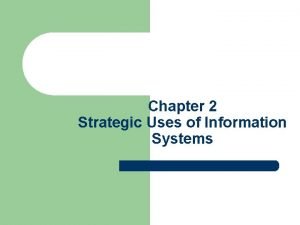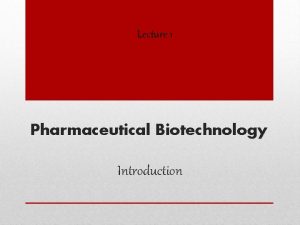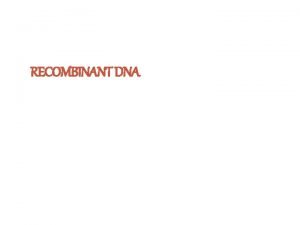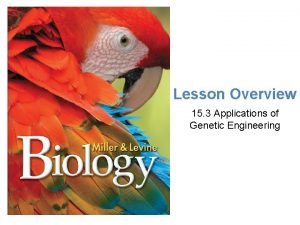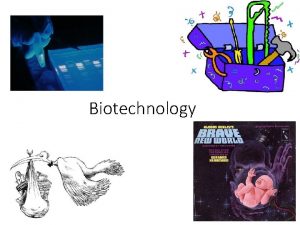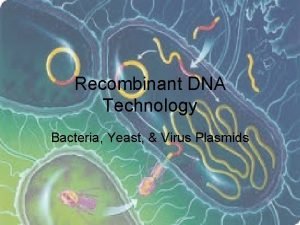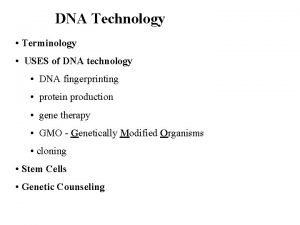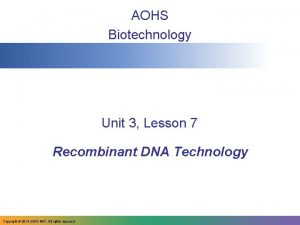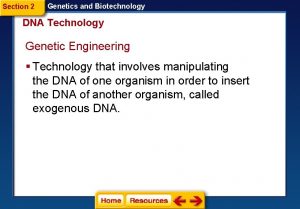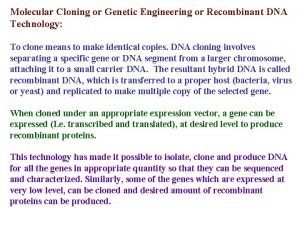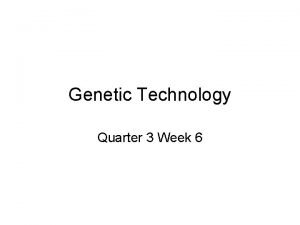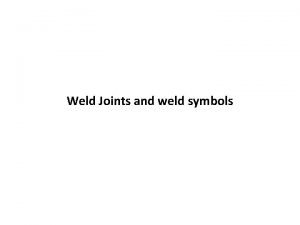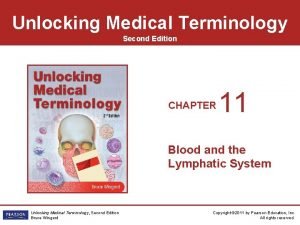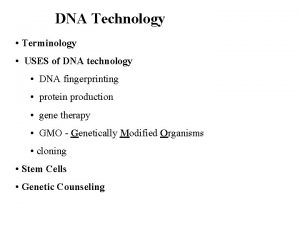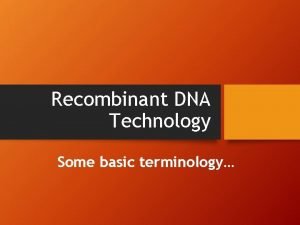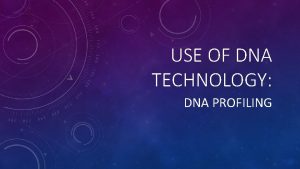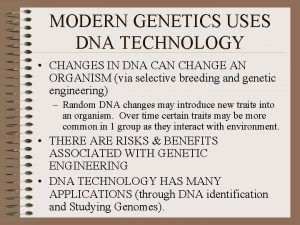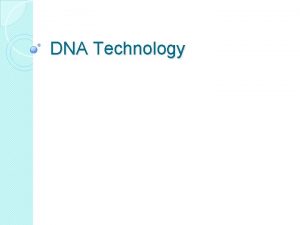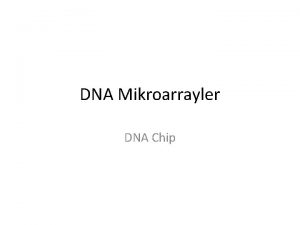DNA Technology Terminology USES of DNA technology DNA






















- Slides: 22

DNA Technology • Terminology • USES of DNA technology • DNA fingerprinting • protein production • gene therapy • GMO - Genetically Modified Organisms • cloning • Stem Cells • Genetic Counseling

Nucleic Acids: DNA & RNA - review • DNA • deoxyribonucleic acid • w/in DNA • genes: specific locations in DNA that codes for proteins or traits • program the production of proteins • determines traits for organisms • RNA • helps in translating code

fig 3. 6 b DNA & RNA - monomers: nucleotides • sugar • DNA - deoxyribose • RNA - ribose • phosphate group • nitrogenous bases • DNA - • adenine (A); thymine (T); cytosine (C); and guanine (G) • RNA - • same, except uracil (U) instead of thymine

Closer Look at DNA molecule - string of nucleotides: • backbone of sugar & phosphate • deoxyribose • four bases • A, T, G, C • double helix • twisted double stranded molecule

Base Pairing: • AT/GC rule – A with T – G with C • 2 DNA strands are complementary fig 11. 11

• DNA gene sequence • m. RNA & t. RNA work together to determine • 3 -base codons code for specific amino acids • sequence of amino acids determine specific proteins

How does proteins affect observable traits of organisms? Example: eye color in fruit flies • normal gene codes for red eyes • Mutations code for brown or white

DNA Technology - Terminology: Restriction Enzyme • cut DNA in specific spots depending on the code in the enzyme Bacterial Vectors • Bacteria used to carry pieces of genetic information from other organisms • plasmids – ring shaped DNA • Recombinant DNA • Bacterial plasmid and inserted gene

Restriction Enzymes: • cut DNA • enzymes • cut at specific base sequence

Forming Recombinant DNA using Restriction Enzymes: • cut DNA at specific sequences creating fragments • addition of DNA from other source • new DNA fragment created • joined by ligase

Making “customized” bacteria

Uses of DNA technology: (1) DNA fingerprinting • Extract a sample of DNA • break cell & nuclear membranes • cut DNA with restriction enzymes • separate DNA fragments using electrophoresis • Make DNA visible by staining and attaching to radioactive markers fig 11. 2

Gel Electrophoresis: • DNA is a negatively charged molecule • placing it on a special liquid gel and running current through the gel will cause DNA to move from negative pole to positive pole • the large fragments move the least • Smaller fragments move the farthest fig 11. 2

Reading the gels: fig 11. 5

Uses of DNA technology: (2) Protein production • use of microbes & cultured cells • produce • bacterial clones grown • protein fig 11. 12

Uses of DNA technology: (3) Gene Therapy • patient has defective gene • • • virus • inserts • bone marrow stem cells have potential to develop into different blood / immune cells fig 11. 19

Uses of DNA technology: (4) Genetically Modified Organisms • • “increase” • bt. Corn (resistant to corn borer) • golden rice (increase of Vitamin A production)

Uses of DNA technology: (4) Cloning • clone: genetic replica • reproductive cloning • • therapeutic cloning • • • fig 11. 17

Stem Cell categories • Totipotent – – • Pluripotent –Embryonic Stem cells (ES cells) –Embryonic Germ cells (EG cells) – – a single cell – source: – ES: – EG:

Stem Cell categories • Multipotent –can differentiate –Hematopoietic stem cells (HScs) – umbilical cord blood – bone marrow • Unipotent – –

Genetic Counseling: • Genes for particular disorders are known • • • may be markers than can be tested for • determine probability of • Huntington’s Disease • • Breast Cancer •

Genetic Testing // IVF Genetic Screening • pedigree analysis or direct genetic testing available for Cystic Fibrosis • parents with a family history of Cystic Fibrosis can screen embryos for the disorder PRIOR to in vitro fertilization • • fertilization occurs • single cell removed • embryos • first child as the result of this screening born in 1990
 Uses of dna microarray
Uses of dna microarray Storage device that uses laser technology
Storage device that uses laser technology Vertical information system
Vertical information system Replication
Replication Bioflix activity dna replication lagging strand synthesis
Bioflix activity dna replication lagging strand synthesis Coding dna and non coding dna
Coding dna and non coding dna Replication process
Replication process Dna rna protein synthesis homework #2 dna replication
Dna rna protein synthesis homework #2 dna replication Pharmaceutical biotechnology notes
Pharmaceutical biotechnology notes Recombinant dna technology applications
Recombinant dna technology applications Define recombinant dna technology
Define recombinant dna technology Complementary genes example
Complementary genes example Recombinant dna technology applications
Recombinant dna technology applications Which career combines dna technology and forensics
Which career combines dna technology and forensics Recombinant dna technology
Recombinant dna technology Recombinant dna technology
Recombinant dna technology Recombinant dna technology
Recombinant dna technology Recombinant dna technology applications
Recombinant dna technology applications Enzymes used in recombinant dna technology pdf
Enzymes used in recombinant dna technology pdf Recombinant dna technology applications
Recombinant dna technology applications Pie chart terminology
Pie chart terminology Plug weld symbol
Plug weld symbol Chapter 11 medical terminology
Chapter 11 medical terminology
